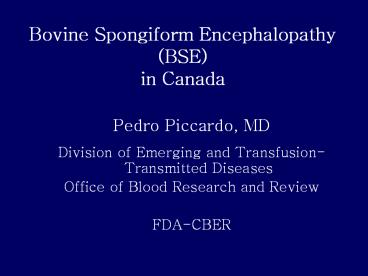Bovine Spongiform Encephalopathy (BSE) in Canada - PowerPoint PPT Presentation
1 / 12
Title:
Bovine Spongiform Encephalopathy (BSE) in Canada
Description:
All farms receiving feed (not intended for ruminants) ... 2 farms. ... of MBM on last farm where BSE cow lived; the farm was depopulated and animals tested. ... – PowerPoint PPT presentation
Number of Views:66
Avg rating:3.0/5.0
Title: Bovine Spongiform Encephalopathy (BSE) in Canada
1
Bovine Spongiform Encephalopathy (BSE)in Canada
- Pedro Piccardo, MD
- Division of Emerging and Transfusion-Transmitted
Diseases - Office of Blood Research and Review
- FDA-CBER
2
BSE Background
- First described in UK in 1986 (gt180,000 cases in
UK cattle to date) - BSE present in most countries of Western Europe
- Peak of the epidemic in UK 1992-1993
- Surveillance in Canada began in 1992
- BSE detected in Alberta in 1993 (in one animal
imported from UK) - BSE recently found in Japan, Israel, Slovakia,
Czech Rep, and Poland
3
Basic assumptions
- BSE first arose in UK and was propagated through
the recycling of infected bovine tissues into
ruminant feed (meat-and-bone meal). - The export of infected animals and infected feed
from the UK spread the BSE agent to other
countries were it was recycled and propagated via
the animal food chain.
4
1997 Ruminant Feed Bansin North America
- Canada implemented a rule that prohibits the
feeding of most mammalian proteins to ruminant
animals (feed ban). - US implemented a similar rule the same year.
5
Variant Creutzfeldt-Jakob Disease(vCJD)
- vCJD is a neurological disease in humans
attributed to consumption of meat products from
BSE-affected animals. - Most vCJD cases have been in UK (135).
- vCJD was found in 5 other countries Canada (1)
, France (6), Ireland(1), Italy (1), USA (1) - Patients in Ireland, US , and Canada had spent
extended time in UK. - Some patients in France and the Italian patient
had not visited UK. - France imported significant amounts of beef from
UK.
6
BSE in Canada 2003
- Jan 31 An older breeder cow (6-8 yr) in Alberta
was condemned with diagnosis of possible
pneumonia and slaughtered (BSE not suspected). - Head was collected and stored, carcass sent to
inedible rendering for pet food, industrial
use. Brain was not examined immediately due to
backlog. - May 16 BSE diagnosed in Alberta provincial lab by
immunohistochemistry (PrPSc in medulla). - May 18 BSE confirmed in Winnipeg.
- May 20 BSE confirmed in UK as typical BSE.
Canada announced case USDA import prohibition.
7
Rendering
- Canadian authorities assured that the carcass had
not entered human food chaininedible rendering
only. - Rendered product went to
- 8 feed mills. All farms receiving feed (not
intended for ruminants) contacted to determine if
any ruminants on premises. If so, they were
further investigated. - 2 farms. Depopulated, could not rule out
inadvertent feeding of poultry feed to cattle on
same premises. - Pet food manufacturer (Alberta). Dog food was
shipped to one firm in US. There is no evidence
that dogs contract any TSE. US firm asked
customers to return food to distributors for
proper disposal.
8
Canadian Response Plan(lines of inquiry)
- Feed Over 200 farms have been investigated,
found in compliance with required feeding
practices. - Case herd No information available about use of
MBM on last farm where BSE cow lived the farm
was depopulated and animals tested. - Trace back Search for the possible birthplace of
BSE affected cow (probably Saskatchewan, possibly
Alberta) was completed. Herds where BSE cow
co-mingled (potentially exposed to same feed)
were investigated. - Trace forward Herds where offspring from case
herd might have lived were investigated.
9
US Follow-up
- US federal agencies (FDA CVM Center for
Veterinary Medicine, FDA ORA Office of
Regulatory Affairs, USDA APHIS Animal Plant
Health Inspection Services, USDA FSIS Food
Safety Inspection Service) are following up 5
bulls imported into the US from one possible herd
of origin of BSE cow.
10
Results
- Approximately 2700 cattle brains have been
analyzed by rapid test (PrPSc ELISA) and
immunohistochemistry. - All animals tested negative (except for the
single positive index cow). - Approximately 25 farms have been investigated
- (Alberta, Saskatchewan, British Columbia).
- June 9 Canadian Food Inspection Agency (CFIA)
announced that active investigation of the case
is ending. Additional testing and information
gathering will continue. An international review
team (OIE) in Canada is evaluating the situation. - A recent risk assessment (Dec 2002) had indicated
that the likelihood of BSE affecting cattle in
Canada was very low. - Current prevalence of BSE in Canada must be very
lowrisk probably lower than before 1997.
11
BSE Canada Further Information
- BSE in Canada will be a topic of discussion at
the next meeting on July 17-18, 2003 of the - FDA Transmissible Spongiform Encephalopathies
Advisory Committee - The Canadian Food Inspection Agency (CFIA)
maintains a web site at - http//www.inspection.gc.ca
12
Agenda TSEAC July 17-18
- Safety of bovine gelatin in oral and topical
drugs, food and cosmetics - BSE in Canada and potential implications for
FDA-regulated products - Decontamination of medical equipment and
facilities (FDA-regulated devices, human tissue
establishments)































